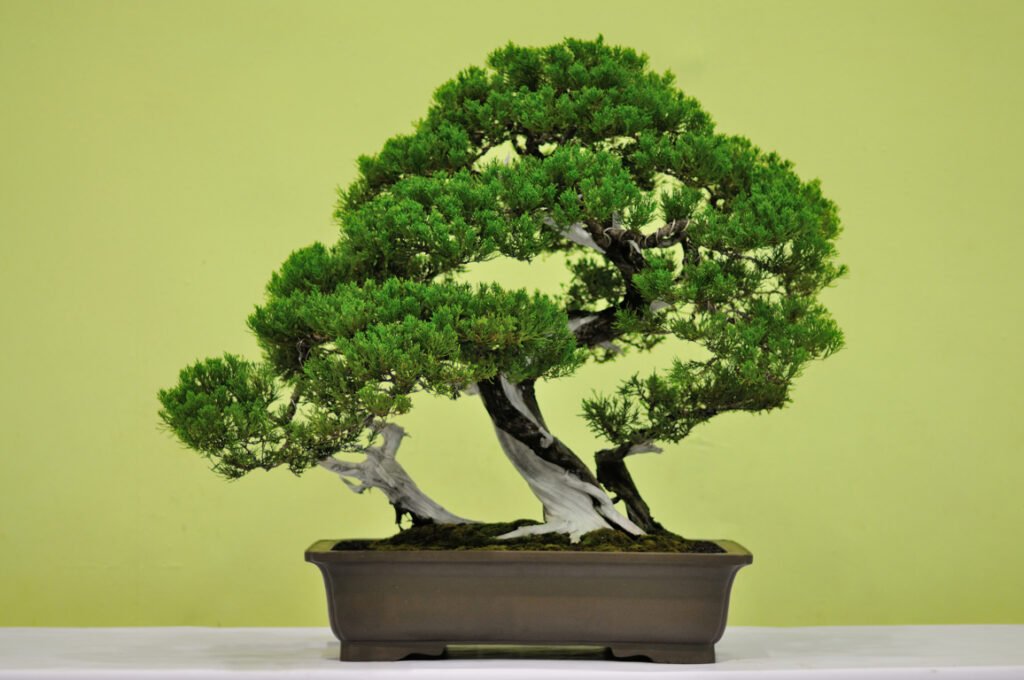Bonsai is an art developed in China thousands of years ago, further developing in Japan, where it spread to the rest of the world. It involves the manipulation of trees through processes such as pruning and repotting, keeping them compact and small. This has been done for centuries, so you might wonder what the most expensive bonsai trees are or what the most expensive bonsai tree in the world is!

There is a variety of factors that can determine the price of a bonsai; it isn’t just age.
Below are some factors which influence the price of a bonsai tree:
Age
One of the most evident and common factors in determining the price of a bonsai is its age. A tree hundreds of years old is a lot more likely to be worth more than a tree around five years old.
It’s only sometimes possible to determine the specific age of a bonsai tree if it has been recorded. However, some techniques, such as carbon dating or counting the rings in a sample from the trunk, can tell you how old the tree is.
You should note, though, that age is one of many factors that will determine the price. Some younger trees can be worth a lot more than older ones, as they may be of higher quality.
Health
Imagine paying for something like a tool – and it comes delivered to you rusty! You’d be outraged, and anyone would be (unless you paid for a rusty tool).
Bonsai are the same. They are also prone to pests and diseases, which can severely affect their health if left untreated for an extended period. Some conditions, such as cankers, are untreatable, and therefore stay with the tree forever, and can cause unsightly cankers.
Therefore, if a bonsai tree is relatively weak and not very healthy, its price will drop compared to a vigorous and healthy tree.
Size
Another quite obvious factor in the price of bonsai is the size.
If you have a bonsai tree that is massive, then it might be worth a bit more than smaller trees! However, it depends on how developed it is. Tiny bonsai – like shohin size, can still go for thousands even with their minute size.
Chances are, though, that if you have a reasonably developed large tree, it might be worth quite a bit more than a very small tree.
The provenance of the tree
If you need clarification on what provenance means – it essentially means where it’s originally from. In bonsai, it is commonly used to describe where it came from and who has owned and worked on it.
Bonsai that used to belong to respected people in the bonsai world or even masters will be worth a lot more than other trees. Many people will buy the bonsai for the novelty that someone with that much experience has worked on. However, this typically means the tree is of excellent quality!
Trees from Japan are usually the most expensive, especially with import costs considered. Chinese trees are slightly lower, and European trees are generally lower than both.
Rarity
Believe it or not, some bonsai trees are much rarer than others.
Species such as maples are a lot easier to obtain than others – this means that they aren’t as rare as others. However, some specific cultivars, such as Deshojo and Arakawa, are slightly rarer, meaning they go for quite a bit more than any ordinary maple.
Cultivars are very important – for example, with Satsuki azaleas. Japanese growers have been attempting to grow an azalea with yellow-coloured flowers for years, and ‘Oryu’ was one of the first. Due to this, the price of an Oryu tree is quite significant.
Quality
I think that the most critical factor in determining the price of bonsai is quality. When buying a bonsai tree myself, I don’t specifically look for things such as age; I’m more bothered about the quality of the material.
If it’s low-quality material, such as a little twig that was propagated a few years ago and has only had a bit of pruning done with no potential that I can see, then chances are that I won’t buy it.
However, suppose it’s high-quality material with some exciting features, or I can see potential in it. In that case, I’m likely to buy it and pay a higher price than the lower-quality material.
So, what are the most expensive bonsai trees?
1) A Juniper Bonsai at Mansei-en Bonsai Nursery
One of the most expensive bonsai trees sold was a juniper tree located at Mansei-en Bonsai Nursery in Japan.
Junipers are considered quite a sought-after tree, and this one was sold for $2 million in 1981. This makes it the most expensive bonsai tree ever sold at auction.
In particular, this juniper was 250 years old!
2) A Ficus Ginseng Bonsai in Vietnam
Although the price has never been listed and not much is known about the tree, a ficus bonsai in Vietnam has a value that is said to be in the millions.
However, the collector of this ficus bonsai has yet to allow evaluators to put a definite price or age on the tree!
3) A White Pine Bonsai at Shunka-en Bonsai Museum
Sold for $1.3 million, this white pine is quite pricey! It’s said to be over 800+ years old, which makes it one of the oldest trees on this list.
It was grown by Master Kunio Kobayashi at the Shunka-en Bonsai Nursery in Tokyo, Japan. Kobayashi bought it for $1.3 million and displayed it at the museum.
4) Yamaki Pine Bonsai at the National Arboretum
This one was valued at $1 million and is 392 years old.
It was shipped to the United States in 1976 by Masaru Yamaki and sent as a gift by Japan to celebrate the 200th anniversary of America.
Ownership is now by the National Arboretum, including information about its history provided by Yamaki’s grandchildren.
5) A Chinese Juniper in Japan
Not much information is listed about this, but it was sold for $750,000 in Japan, presumably at an auction.
Chinese Junipers are also quite sought after in bonsai and are considered one of the more expensive bonsai trees.
6) A Five Needle Pine Bonsai
In Japan, a five needle pine was sold in an auction for $600,000. Pines typically live for over 500 years; this one was estimated to be around 300 years old!
Five needle pines grow quite quickly and are one of the fastest-growing bonsai, making it pretty sought after. Learn all the aspects of growing pine bonsai from seed.
7) A Zelkova Bonsai owned by Kimura at Omiya Bonsai Village
Masahiko Kimura, a famed bonsai artist, had one of his Zelkova bonsai valued at $106,000. It is currently on display at the Omiya Bonsai Village and is overseen by Kimura.
8) A Pine Bonsai in Japan
Another one by Kimura, this pine bonsai, was sold for $106,000 at an auction in Japan.
Pine bonsai are very sought after in the bonsai world. Therefore their prices are pretty steep! However, the provenance and quality of this tree make it very special.
9) A Ficus Retusa ‘Linn’ at Crespi Bonsai Museum
This particular ficus is known as the oldest bonsai tree in the world and one of the rarest bonsai on this list which is not displayed in Japan.
The Crespi Bonsai Museum is located in Italy, where the owner Luigi Crespi worked for over a decade to buy this specific tree.
It was valued at $91,000 and displayed in the museum’s glass pagoda. However, it was stolen in 2019!
Some of the trees below are more expensive than the ones listed above. However, this is because they have little extensive information recorded about them compared to the ones above.
10) A Shimpaku Juniper in Japan
Although there isn’t any detail of this one online, a Shimpaku juniper sold at auction for $120,000 in Japan.
Shimpaku is a specific cultivar of juniper, with foliage that differs from others, such as Itoigawa.
11) A Japanese White Pine in Japan
They all seem to come from Japan, don’t they? This one was sold for $160,000 at another bonsai auction, and there is little information online about it.
12) A Juniper Bonsai in Japan
At the Taikan-ten exhibition, another juniper bonsai was sold for quite a price!
This one was sold for $180,000, and due to the buyers, only a little information is provided once sold – unfortunately.
13) A Sargent Juniper Bonsai at the National Bonsai & Penjing Museum
At an auction at the Taikan-ten Bonsai Exhibition in Kyoto, Japan – a Sargent Juniper was sold for $350,000. Its approximate age is 107 years old.
The exhibition happens every year in November, with the ‘Prime Minister’s award given to the winner each year.
14) A Juniper at Shunka-en Bonsai Museum
Shunka-en is one of the most amazing bonsai museums in the world, with the most expensive trees! One of them is a juniper tree valued at $400,000.
15) A Black Pine in Japan
Once again, at the Taikan-ten Bonsai Exhibition, a very expensive tree was sold!
In particular, this one was a black pine. It was sold at $58,000, and it deserves that price! The quality of the tree is impressive, especially the carefully crafted foliage and trunk.
Frequently Asked Questions (FAQ)
How do I determine how old my bonsai tree is?
Unless you want to cut your bonsai tree down, it’s not likely that you’ll be able to determine its exact age of it. However, if you did – you could count its rings to determine how old it is! If you don’t want to do this, there’s another way. You can multiply the diameter by the growth factor, which should roughly equal the tree’s age – however, this is not always accurate as growth will depend on the environment
What is the most expensive bonsai tree species?
I would say that the species that end up costing the most are normally either pines or junipers. These are usually the most sought-after species, and there are lots of specimen trees that are pines or junipers. Get growing!
How much can I buy a bonsai tree for?
It depends on how developed the tree you want to buy is! If it’s quite a small, undeveloped tree, then you can get it from around £20-50. However, if it’s a fully established and quite developed bonsai, it can be around £500 or more. Make sure you take into account the factors which I have listed at the start of the article, though, such as age, rarity, provenance, quality, health, and size.
What’s the cheapest tree I can buy?
Why buy a tree when you can get one for free? That’s right – a lot of trees you can get for free; it just requires a bit of time. Consider picking up seeds from your local area from trees that have dropped them or taking cuttings from said trees. This is a cost-free way of propagating plants, but make sure that you always have permission before you start snipping anyone’s trees!
How long do bonsai live?
Depending on the species, some bonsai can live for over 500 years, such as pines. However, some will have a lot shorter lifespans due to factors such as instability when they grow quite thick – their wood may weaken and rot, eventually leading to the tree dying.



